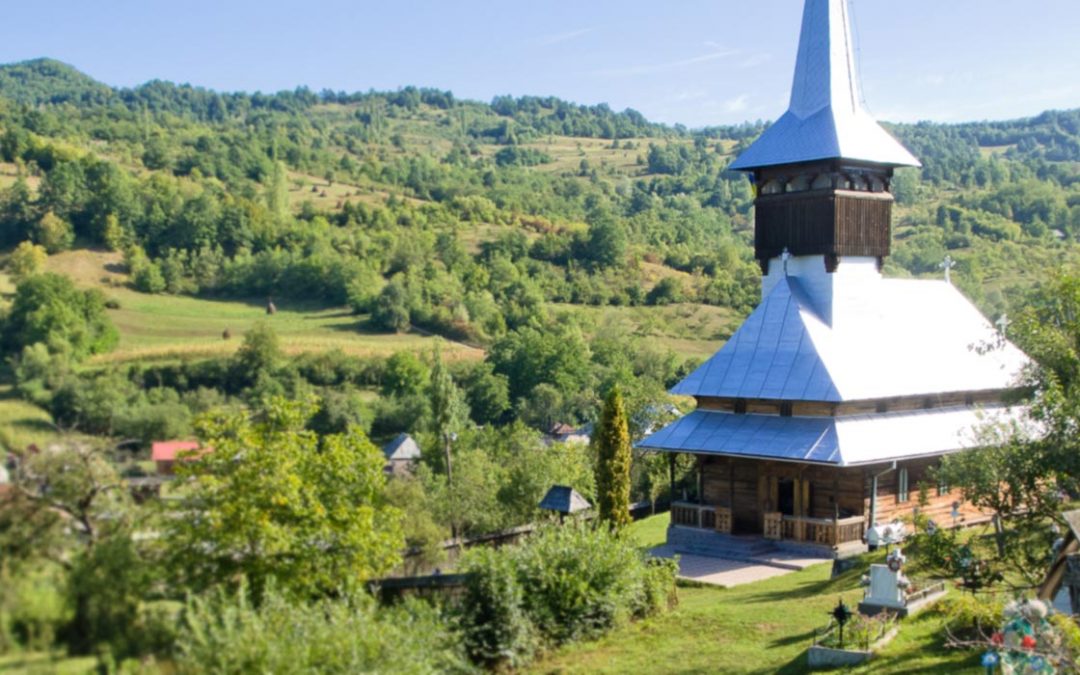In the far North of Romania, in the heart of Transylvania, lies the region of Maramures. Unscathed by the industrialisation of Romania’s communist period the Maramures region showcases a spectacular landscape married with centuries old agricultural and pastoral traditions. Snow capped mountain peaks, ancient forests and an amazing diversity of fauna and flora – some of which are long lost and forgotten in other parts of Europe – all combine with an ancient way of life.
Ringed in by mountains Maramures has long been kept isolated, thus preserving a way of life which has been passed by in Western Europe. As you travel through the enchanting countryside you’ll see farmers making hay in the traditional manner amongst spectacular wooden churches, some of which fall under UNESCO patronage. Entering the towns and villages of Maramures is the closest you can get to stepping back in time: farmers ploughing with bulls, carriages pulled by oxen, rugs dyed with natural plant extracts, beautiful wooden houses with intricately carved wooden gates; historic churches, regional customs, dances and traditions. This is no Disneyland, there is no performance for the benefit of the tourists – this is real, authentic life in Maramures.
The Rodnei Mountains with the Pietrosu Peak – at 2303m the highest in the Eastern Carpathians – are made up of volcanic rock and their inner rim forms the longest chain of volcanic mountains in Europe. With their deep valleys, sharp crests and glacial lakes the Rodnei Mountains provide a natural reserve for a breathtaking array of flora and fauna: chamois and marmots or, if you’re lucky, eagles, capercaille and black grouse. The Waterfall of The Horse (80m high) is a worthwhile day excursion, and you may also come across some of the many undiscovered and unmapped caves of the region. The Cresta Cocosului offers spectacular views and, for the more adventurous, some fantastic climbing routes on its abrupt cliffs.
Away from the mountains are the region’s vast and ancient forests of spruce and oak. Here bears, lynx and wolf still roam in evidence of Romania’s healthy and unique biodiversity. The alpine pastures are still used by the shepherds who keep a watchful eye over their flock. These mountain pastures, aesthetically scattered with haystacks, are living proof of the interaction between the people of Maramures and the nature which surrounds them. Walking through the freshly cut fields in silence and in harmony with nature perhaps represents the best break from city life, it’s pressures and excesses.
The water habitats of the region, from the glacial lakes with their clear pure waters, to the marshes of the wetlands, offer an unexpected beauty to those who discover them. The rivers of the Viseu, Vaser, Mara, Cosau, Isa and Tisa populate this region where the otter and the Danube salmon still live, along with dragonflies and water birds. Here traditional fishing is still practiced, women wash their clothes in the rivers and giant watermills dot the river banks. From the mountains to the meadows, forests and wetlands, this landscape presents a wonderful world. Our survival as a species is dependant on our capacity to preserve the balance between nature and ourselves. Here, in many ways, we can see how we once achieved this.
When you enter the villages you will see this rural life in close up: the traditional wood carver and hatter; women who produce wonderful jewellery, woollen rugs, cloth and traditional costumes. Here you will see people at work in regional clothes that have barely changed in hundreds of years; and a wide variety of ethnic groups – Romanians, Hungarians, Germans, Jews, Ukrainians and Gypsies – all mixing to provide a unique combination of architecture, clothing and traditions. There is also the opportunity to stay in agro-tourism accommodation, to witness at first hand the villagers’ life, to eat their food and to share a palinca with your hosts. Palinca is the traditional drink of the region brewed from plums and double distilled, this so called fire water is a part of the villagers’ lives as well as the visitors’.
Sighetu Marmatiei, the centre of historic Maramures, was first mentioned in 1326. Seen from an elevated position from the top of the Solovan Hill, the town is seen to be dominated by churches many centuries old. A tour of the old city centre will familiarise you with the old Jewish merchant houses and old administrative buildings: the former County Council, the City Hall and Culture Palace. There is the Ellie Wiesel Memorial House, a famous son of the city who was awarded the Nobel peace prize, the monument of the Holocaust, and the Memorial of the Victims of Communism. There is also the History Museum to wander around with axes from the stone age, silver and gold jewellery, the Ethnography Museum, the Natural Sciences’ Museum and the Village Museum all of which offer the chance to better get to know this fascinating region and its past.
Ecological and cultural tourism in Maramures can open up new perspectives for the visitor in a place where nature and traditions survive and co exist in the geographic centre of Europe. A visit to Maramures can be an enchanting and fulfilling experience, opening up new horizons and giving us a greater understanding of our complex relationship with nature and our surroundings. For those of you who visit Maramares you will experience a truly unforgettable and privileged experience that will certainly make you leave yearning to come back.

